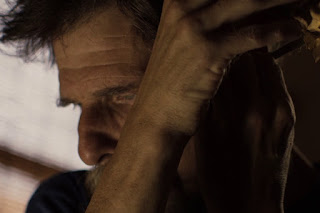Article initialement publié sur le site du Film and Digital Times magazine, grâce à l'aide de Jon Fauer
A
simple idea refreshed in Camerimage 2016
Who
is making the choice of seeing?
Reflection
around two short documentaries : Unseen :
the lives of looking (director
and cinematographer Dryden Goodwyn, UK) and How
to destroy the time machines
(director
Jacek Piotr Bławut, cinematographer Adam
Palenta, Poland)
Bydgoszcz,
Poland, Camerimage festival. The marvelous international festival
dedicated to the art of cinematography. This is all about Directors
of Photography, and even more when you look at the documentary
program, where most cinematographers are also directors. What they
offer you too see is almost literally their own vision of the world.
In those cases, the communication with the viewer, the mise
en scène,
is almost entirely contained in the cinematography : framing,
angle, focal lengths, movements… According to me, it is one of the
main interest of documentaries : how do these directors see the
world and how do they manage to communicate it through the cinema
screen.
How
do other people see the world? How does it affects them ? And
how do they communicate it ? The quest of Unseen :
the lives of looking director
Dryden Goodwyn is to explore this enigma. Dryden Goodwyn reached
three people whose look is oriented very differently, which makes
each of them differently conscious of their place in the world.
The
first character, an eye-surgeon, is looking to the world in great
details, very deep into the infinitely
little, through a microscope. The second character is an astronomer
studying the surface of Mars, another planet millions of miles away.
He is focused on the cosmos and the infinitely wide. He explores a
very precise 3D map of Mars which he builds thanks to photos taken by
the Curiosity rover.
It
becomes his everyday landscape so much that he sometimes forgot that
it is a complete other planet. The third part of the movie focuses on
a London
lawyer who is looking at our society, that is to say « the
surface » of the world, as Dryden Goodwyn explained it in the
Q&A session after the screening. This last character analysis of
the world depends on how we have come to organize it, our rules, laws
and institutions.
Step
by step, the portraits of these three characters reveal the main
statement of this short movie : everything we see and think is
mediated through something, microscope, photography, institutions or
lens, camera, screen. The director doesn’t forget indeed to
highlight his own mediation, firstly through his drawings, but also
through his cinematography. In the beginning, even though his main
focus is on his own drawings, that is to say his own interpretation
of what he sees, he also fulfills our illusory
need to see its subjects without his mediation. That’s why he edits
alternatively his drawing and the filmed portrait of his model.
But the more the
film evolves, the less Dryden Goodwyn leaves us the illusion of this
« direct », unmediated point of view. Still, fulfilling
our curiosity, he tilts from his paper to his model, but very briefly
and always out of focus. This blurring means everything : the
choice to see does not belong to the viewer. What prevails is the
director's choice of showing.
In
How to destroy the time machines,
by
director Jacek Piotr Bławut and cinematographer Adam Palenta,
the use of blurring is also a cinematographic choice that enhance the
meaning of the movie. The
very narrow depth of field is relevant to illustrate the finesse and
accuracy of the sounds Jeph Jerman, the main and only character,
listens to and records.
But it is also the choice of not seeing
accurately the context, the whole action. The camera seems to wait
for its subject (the moving hand, the turning rocks) to enter into
the tight focus field. The focus is fixed and then left to luck, as
if “destiny” had to choose what is relevant to see or not to see.
The blurring becomes a new way of framing. The cinematographer does
not always choose the obvious center of attention, and sometimes
steps aside the whole subject to just seize a short glimpse of it. It
reminds the viewer that what we focus on is a part of a whole which
can never be photographed entirely. Every frame is an on-the-spot
choice of a characterized cinematographer.
This
is the main lesson told, repeated and renewed at every screening in
Camerimage: each cinematographer has his own way to shoot, and that's
what we're here to see. And into a frame, the attention is
traditionally directed towards the focus point, but sometimes, the
imagination flourishes in the blurring. I guess that’s why my
Polish host told me about a
photography
of a blurred girl in the middle of a dance stage he took : « It
is my kind of creativity. »
Axelle
Coquelet
Second
year Cinematography student in La CinéFabrique, french cinema school
in Lyon
Graciously
invited in Camerimage by Transvideo, Aaton and K5600




















